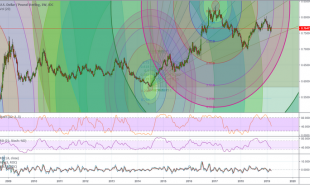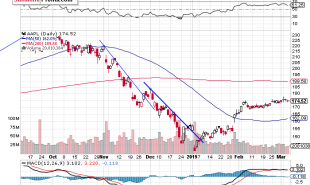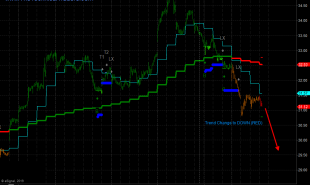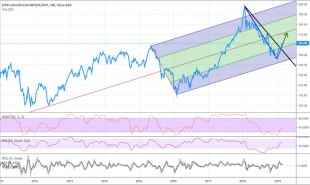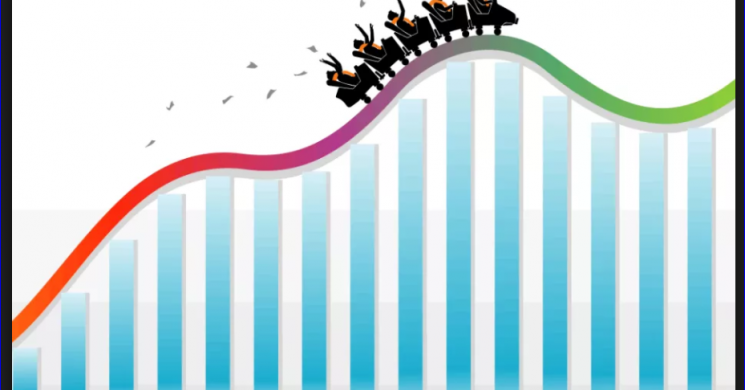
UPDATE: Given market behavior the last few days and the destruction of short volatility players who actually sold Vol as a dividend for their portfolios; check that- YOUR portfolios if your money is in a pension fund;
We thought it proper to trot out this rather clear explanation and prediction made less than 2 months ago of exactly how the public is getting the shaft this time. And it is happening right now.
But before we do, here is where things are right now.Here is an ETF called XIV, a wonderful product that makes it easy to short volatility. It moves on the opposite direction of the VIX.
This chart shows it down 14% in regular trading hours. It is down another 36% in after hours as of 5pm tonight.
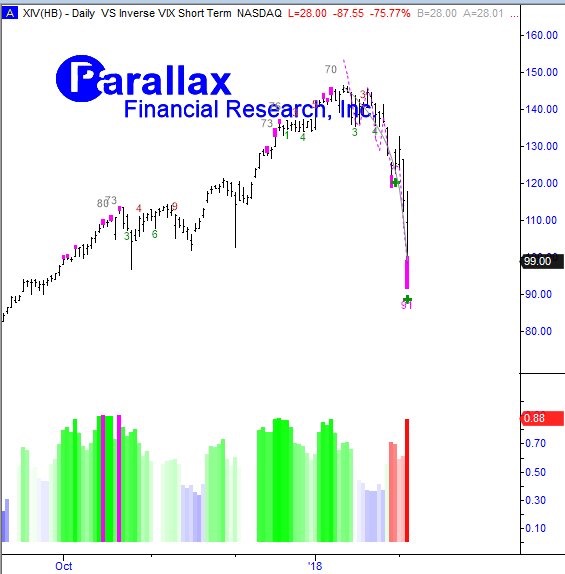
That is how people are getting their faces ripped off. Margin calls are coming in.
Here is a walkthrough of how greed and Wall Street product enablers combine yet again to destroy your wealth.
Pensions Strapped for Money to Pay Retiring Boomers are Going to Die as They Hunt for Yield By Shorting Naked Vol.
History does not repeat itself, It does however, hum the same melody
Intro by Vince Lanci
This is the way the next crash will likely come. The need for yield by pension funds to actually pay their retirees makes them prime targets for bank ideas to create yield. Ideas like "just sell vol" are now being lapped up. And like those old school sellers of strangles to capture premium, and the users of "Portfolio Insurance" pre-1987, they have been right along time now. But it takes only 1 time to be wrong, and that pension will blow up. Who is on the other side of those short vol positions we wonder?
The 1987 Crash Cause was Portfolio Insurance & (No) Exit Liquidity
The ludicrous Wall Street strategy/ idea pitched to investors known as Portfolio Insurance is what caused the 1987 crash. This risk has essentially been recreated from my point of view in the naked selling of the VIX in combination with the passivity of investors as exemplified by products like ETFs.
The New Crowded Trade
With the need for yield, pension funds are now selling volatility for income. One would think this is not unlike selling covered calls on Gold or a stock you own. But that is not the case here at all.
What is happening now is fund managers who need to perform for their retiring pensioners are simply shorting volatility as an asset class itself. They are not writing calls against a long stock to create income without adding to downside risk. In fact, many will be forced to buy stocks at higher values than they are trading in a collapse. They are selling PUTS as well as Calls either directly or via the VIX index. Thier risk is volatility added on top of their stock price risk. They are naked short an asset that is essentially a Texas hedge for stock longs.
Caveat: that is not to say the Fed won’t ensure vol stays manageable to keep from collapse. The proceeds are profits made from vol longs. Buyers are subsidizing pensions. Remember, the Fed can stay irrational longer than you can stay solvent. And when it comes down to it, pot odds may dictate actions in the future. So while I outline the recipe for disaster below, even the best risk reward scenarios don’t pay off sometimes. Just saying.
How 1987 Happened
Back then, stock holders were told to sell indices if their particular stock went down. How it likely went down as a broker advises his client who is long IBM:
Market lower?... sell stock index futures... If it goes lower, sell more. IBM is great. it is the broader market we have to be careful of dragging IBM down unfairly.
This created a self reinforcing cycle as arbitrageurs sold shares while long stock holders sold futures to hedge their position.
Fundamentals Did Not Matter in 1987 And They Don’t Now
You see, these people believed the stocks in their portfolio were GOOD. The advice given by Wall street at the time was to NOT sell your longs as they were good. But rather sell broad indices to hedge your market risk. This was before the ability to buy put was facile The killer is, these people were told to sell into weakness, not to put on a hedged position at the beginning. It was insane. This was a product/ idea created by Wall street firms to generate commissions with no regard to exit liquidity. It was a crowded trade.
The same thing is happening again. Pension funds are betting on the Fed to give them the "put" back. The much used metaphor of the "Fed Put" is now being assumed to be real. to repeat: They are not short options against an asset. And the more Vol goes against them, the more they sell. They are betting on a regression to the mean concept with no regard for margin calls or bank roll management.
How It Will Happen Again
Pension funds selling Vol, like Portfolio insurers before them, are going to be forced to play the martingale roulette wheel approach to investing. The further your position goes against you, the more you sell stock indices to hedge your particular stock. Double down until you make your money back and no "0" or "00" please.
GOLD EXAMPLE:Stock holders were actually told to sell their Gold instead of selling their stock losers. If you are old enough, Gold was called limit up in 1987, and ended limit down form stock longs selling to maintain their stock positions.
The New Crowded Trade is Short Vol
Volatility of an asset is not risk per-se. Bank roll management, length of time a position is held and other factors reduce it to noise ifproperly managed. But what if Volatility of stocks is the asset being shorted itself as some sort of income stream for a stock portfolio? Not just Calls, but Puts as well. The major component (Volatility / Time value) of the very instrument (Puts) used to hedge directional stock risk is being shorted as well now. The more premium collected the better.
Further, In a declining stock market, Volatility will move consistently with the dominant players position. These are stock longs we speak of as "dominant". The "tell" of who has the biggest risk is in the volatility smile's skew. That skew tells me and every other option guy that stock longs are the dominant (not necessarily the strongest) players.
Skipping a few steps; in the stock market, lower prices cause an increase in implied volatility due to an inverted correlation and the stochastic nature of volatility. Simply put, unhedged stock longs will buy puts hand over fist in a washout to hedge their downside. And that will trigger Pension fund losses from short Vol positions against no other asset, or worse, pensions will have to buy stocks at prices above where they are trading.*
And the more it goes against them, the more they sell. They are betting on a regression to the mean concept with no regard for margin calls or bank roll management.
Here is what is scary. Those Pension managers selling vol are jumping on a band-wagon environment created by the Fed. And, like Portfolio Insurance, they will sell more as it goes against them. They are doing what is almost exactly like that ill-fated, poorly conceived, no-accounting-for-exit- risk in VAR concept Wall Street sold them that lead to the 1987 crash.
This is the way the next crash will likely come. The need for yield for pension funds to actually pay their retirees makes them prime targets for bank ideas to create yield. Ideas like "just sell vol". And like those old school sellers of strangles to capture premium, they have been right almost 5 years running. But it takes only 1 time to be wrong, and that pension will blow up. Guess who is on the other side of those short vol positions.
We bet one pension fund ( preferable a union one)will be permitted to fail a la Lehman. Then the fed will down something about the problem .
Appendix
**Option Wonk Note: The Skew of an option smile on an asset is positively correlated with the stochastic process of volatility in that market. Volatility will move with the asset price itself. in stocks where skew is to the puts, vol generally decreases in a rally, and increases in a sell-off ( provided the Fed isn't keeping a lid on it).
GOLD EXAMPLE: In markets where Vol does not expand in the direction of the skewness, the arb players kill the skew. This is what happened to Gold when GLD became a product. I saw this happen when the GLD players started selling calls and buying puts which flattened the smile in Gold futures. The Next Skew arb trade in Gold options may be to sell Gold puts, and buy mining puts or a variation thereof.
Good Luck
Vince Lanci has 27 years’ experience trading Commodity Derivatives. Retired from active trading in 2008, Vince now manages personal investments through his Echobay entity. He advises natural resource firms on market risk. Over the years, his expertise and testimony have been requested in energy, precious metals, and derivative fraud cases. Lanci is known for his passion in identifying unfairness in market structure and uneven playing fields. He is a frequent contributor to Zerohedge and Marketslant on such topics. Vince contributes to Bloomberg and Reuters finance articles as well. He continues to lead the Soren K. Group of writers on Marketslant.
[Incidentally, there’s is a hedge for the Pension fund risks not discussed in Jim Grant’s interview: the Hedge is in buying calls on the Vix. This is essentially buying the “vol of vol” or leptokurtosis- Now your are getting into some really esoteric hedging- Vince]
Jim Grant Interviews Alan Fournier: "Pension Funds Are So Desperate For Yield, They're Systemically Selling Vol..."
via zerohedge.com
Real Vision’s brand new ‘Jim Grant Series’ kicks off with a rare opportunity to meet Alan Fournier, the founder of multi-billion-dollar hedge fund Pennant Capital. In this clip, Alan reveals the blind spots institutional investors have with volatility.
In the latest installment of Real Vision's interview series featuring Jim Grant, longtime publisher of Grant's Interest-Rate Observer, the newsletter publisher sits down with Alan Fournier, the billionaire founder of Pennant Capital, to discuss one of the most widely discussed topics across modern asset markets: Volatility - or rather, the systemic risks posed by not only the paucity of volatility in modern markets, but how risk parity and low-vol targeting strategies have created imbalances that could lead to massive dislocations should volatility spike.
In the beginning of the talk, Fournier and Grant discuss how volatility has been artificially suppressed for so long that it's essentially become an asset class unto itself. Investors have devised all these new volatility targeting strategies - like risk parity, for example, that have generated outsize returns since the financial crisis. But many don't recognize the underlying risks. With so much money piled into the short-volatility trade, a large enough spike could trigger extremely painful selloffs in both bond and equity markets.
JG: And one would expect that if interest rates are going to turn, it might be kind of a noisy and dramatic turn.
Are you plugging in the interest rate aspect to this as well the bond market side of things?
AF: Well the thing that concerns me the most about this sort of overall technical setup, if you will, is that the reason people own bonds is they don't correlate with stocks. So if something bad happens in the stock markets, bonds rally, right? So risk parity, some stocks in a levered bond fund, it's been fabulous because that's been what we've seen for the last 15 or 20 years. Well if we get a turn, which is just driven by a normal business cycle and that correlation comes apart, who knows what happens? But there's a lot of money that's been dedicated to these kinds of strategies, whether they're vol targeting, risk parity. We're in sort of a spooky time.
JG: You use the phrase the setup, which I think is a wonderful way of expressing the notion of an overall context of things, how the forces are aligned or misaligned. And so many of those forces in this particular cyclical moment seem to be unusual if not unprecedented. Certainly the level, the nominal level and real level of interest rates is one of those forces. The positive preoccupation with the efficacy and with the certainty of outcome of passive investing must be another, right?
AF: Yes.
JG: And the peace and quiet in the markets as reflected in readings in both the MVE Index, which registers bond activity, and the VIX Index, which measures agitation in the stock market, those things are at record or near level lows. So Alan, how do you see the constellation of these forces?
AF: Well, we joke on a trading desk when we come in the morning if the futures are down-- like today they were down a bit this morning. But we joke about what time they're going to go positive during the day, and usually it's after the Europeans go to the pub or something at around 11 o'clock. By 2 o'clock they're positive.
And I just mentioned this because it's very unusual and something I've never seen in 30 years or so of doing this that sort of nothing rattles this market. And I think some of it is the vol being depressed.
JG: Now let's explain this. So volatility now, it's like a thing. It used to be stocks and bonds.
AF: It used to be observed based upon how options are priced. Now it's actually a source of income.
JG: Right. It's like an asset class.
AF: It's a bond.
JG: But it's movement. It's kind of capitalized movement, right?
AF: Right.
Toward the beginning of the interview, Fournier shared a story with Grant about how a high-net worth broker recently asked for meeting to pitch a suite of new "short volatility" investment products. After grilling the broker about the details of how the products are managed, he asked how the funds are protected in case of a sudden spike in volatility. The broker waved his question aside and said there products are all adequately hedged.
[Edit-The Hedge is in buying calls on the Vix. This is essentially buying the “vol of vol” or leprokurtosis- Now your are getting into some really esoteric hedging Vince]
After doing some more due diligence, Fournier discovered that the broker was wrong. And it's not that he lied, Fournier surmised - it's that the broker didn't have an appropriately deep understanding of how the products work.
AF: Yeah. So I'm going to tell you a little story which is interesting, which is suggestive of the idea that we're pretty late in this tick-tock game.
JG: All right, I'm ready.
AF: Well a friend of a friend asked to come see me who is a high net worth broker at one of the investment banks. And he said, "Look, I know I can't help you in the stock market because you're doing your own thing in your fund and get that, but maybe we can help here with fixed income." I said, "Sure, come on by. Let's talk."
He comes in and I ask the question, "So what are people doing for income?" And he said, "We have this great product that sells vol." And I said, "Oh, how does that work?" And, well, it was a very basic explanation. Selling puts, selling calls, straddles, blah, blah, blah. And I said, "What happens if the market goes down?" And he said, "Well, there are ways they protect against that." I was like OK, and I just was very curious. So I said, "Send me the documentation." So he sends me the brochure with all the legal details and so forth, and there's really no protection. They're just selling vol and collecting income, which has been successful.
In the most unsettling excerpt from the interview – for mom and pop investors, that is – Fournier shared a story about a talk he gave to a group of pension-fund investment-committee members. Some investment bank trying to scrounge up brokerage business had taken the group of these investors on a tour of Washington, D.C., and Fournier was recruited to speak about his experiences in the hedge fund industry as sort of a keynote for the day’s events.
So, Fournier told a story that emphasized the risks of selling volatility.
Afterward, his audience sat there, stone-faced. As he would come to find out, many of their funds were running vol-selling strategies which – as we’ve explained time and time again – are much riskier than most investors realize.
And these are pension funds – purportedly some of the most risk-averse institutional investors.
JG: So when you sell vol, what do you do exactly? Do you sell puts on the VIX Index?
AF: Yes, and different tenors. And there are strategies that will sell vol at a level and buy vol further down and try to dampen potential crash risk and those kinds of things. But essentially you're just collecting income by being a house, selling puts.
So a few weeks later another investment bank invites me to come and speak to some pension investors. And they were taken them to Washington to sort of hear what was going on down there. And then they brought them up to New York and I was sort of the end of the day, talk to a hedge fund practitioner kind of thing. And I sat there and I told the story about how this guy was trying to sell me vol, expecting some kind of reaction from them.
JG: And they said so?
After doing some more due diligence, Fournier discovered that the broker was wrong. And it's not that he lied, Fournier surmised - it's that the broker didn't have an appropriately deep understanding of how the products work.
JG: This is a group of--
AF: Pension funds, large European pension funds. And he said, "Yeah, but they have a strategy where, when you get a selloff, they sell more into the selloff." So if the VIX spikes from 10 to 15, you sell more. And then you continue to have this tremendous monthly pattern of income.
So as I was walking out of there I thought, my goodness, the central banks have succeeded in pushing people out on the risk curve. They're taking people that are managing the pensions of state pensioners and they have them in negative earning sovereign instruments. And now they have them-- they're so desperate for some yield, they're systemically selling volatility, which is remarkable.
In one of the most interesting excerpts from the interview, Fournier explains how a chance breakfast meeting inspired him to switch from long subprime lenders to short a few years before the housing crisis began.
The timely switch allowed Fournier to book winning trades on both the long side – he cashed in as home prices climbed toward their pre-crisis peak – and against during the collapse. He was inspired to change his position after learning from a subprime mortgage broker how the loans the broker was selling worked.
After their discussion, it quickly became apparent to Fournier that the whole subprime lending model was reliant on home-price appreciation, and the minute housing prices peaked, there could be a very significant credit event.
JG: This is where we have different lines of work Alan, because in the years 2001, '02, '03, '04, '05, '06, Grant's Interest Rate Observer deplored these queues of people lining up irrationally and uneconomically to buy the houses, the makers of which you were long.
It takes all kinds of people to make a world. I’m not throwing stones.
AF: We also got long subprime lenders. And we got to know them well. And early on it was clear that this was going to be a booming opportunity for subprime lenders. I mean, you were taking debt that was costing folks very high rates on credit cards and pulling equity out of homes. And so that was a natural arbitrage that created this big opportunity. And then using subprime to fund the purchase of second homes, driving up real estate prices. And I was actually at a breakfast with a company coming public that I ended up investing in where I asked them a number of questions about how these loans work. And it became very clear that the whole key to those loans was home price appreciation. And at that breakfast, I kind of logged this view, that, wow, when this turns, it's going to be a very significant credit event.
JG: Let me, if I may just interrupt to observe, how unusual it is for someone who has been long, a big theme, to turn around and successfully to change views and become short, successfully, that same theme. It's done sometimes at a bar in recounting fabulous fabled stories, but rarely in real life. Tell me about kind of the intellectual flexibility this requires. When did you decide to kind of jettison the bullish view on subprime?
AF: Well, it was a matter of first developing understanding of what was going on and how this reflexive process, classic Soros reflexive process was interacting with the real world. And it was very simple. Easy credit drive up home prices. The fact that home prices was growing up was making credit easier. And so it was a matter of how long that would play out and when it would end. We had the patience to wait. And we made some money in long side of some of the subprime lenders during this period. And it was really gaining the knowledge of what these CDO and CDS securities were that was an eye-opening opportunity for me.
So Fournier switched from being long doomed mortgage lenders like American Home Mortgage to shorting the mortgage-backed security products that would eventually slide all the way to zero.
Later in the interview, Grant asks Fournier for his thoughts on bitcoin.
In a heartening display of modesty and intellect, Fournier demurred, instead of offering a barrage of chaotic, unqualified opinions like some of his peers have tended to do.
“That’s something I don’t understand well.”
Something strange is going on in the financial system. And according to The Wall Street Journal, it’s causing some investors to move massive amounts of money out of the banking system. Read More
Read more by Soren K.Group


